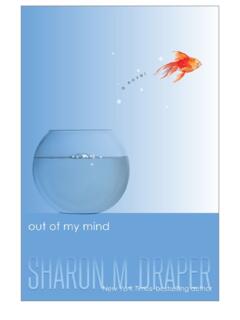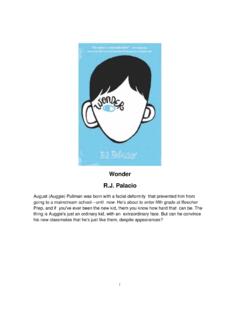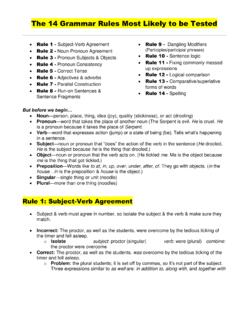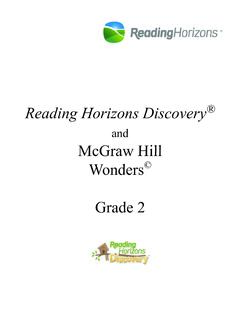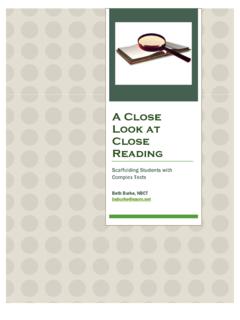Transcription of Introduction: The Structure of a Poem - English Creek
1 Stacey Lloyd 2014 UNDERSTANDING POETRY Introduction: The Structure of a Poem Poets utilize structural elements of poetry in order to successfully convey the meaning of their work. The stanza Structure ; the length of the lines; sound devices; word choice they all aid the creation of tone and mood in a poem, and work together to present the meaning. It is important that you have a good understanding of the structural elements of poetry, so that you can understand how they work to support and carry the ideas of a poem. FORM Form, in poetry, can be understood as the physical Structure of the poem: the length of the lines, rhythm and meter, the system of rhymes and repetition etc.
2 Certain specific poetic forms have been developed over time in different cultures. Examples of such forms are: the sonnet, haiku, the villanelle, ballad etc. Questions to ask: Is the poem an example of a particular form? If so, what? STANZA Structure One of the most fundamental structural aspects of a poem is the stanza. Generally speaking, the stanza is the arrangement of lines into groups, separated by an empty line - similar to verses, or paragraphs. Stanzas are often named according to how many lines they contain; for example, a four-line stanza is called a quatrain.
3 Questions to ask: Is the poem divided into stanza? If so, what type, how and why? RHYTHM & METER Each line of a poem will have its own Structure , and the meter is the rhythm and sound pattern of a line of poetry. The rhythm is important as it gives the poem its sound and differentiates it from prose. The meter is defined by the pattern of stressed and unstressed syllables in a line. Questions to ask: Is there a set meter? If so, what is it? If not, what effect is produced? LINE Structure Lineation dictates when a line of poetry stops and a new line begins.
4 When analyzing a poem, the line Structure is essential; poets choose to place words in a certain order for a reason, and the construction of their lines is important when understanding the tone and meaning of the poem. Questions to ask: Where are the line breaks? What effect does this have when reading ? SOUND EFFECTS Poets employ techniques of sound to enhance their poems. The way the words and lines sound to the reader will affect the mood, tone, fluency and possibly even the meaning of a poem. Questions to ask: What sound devices are used?
5 What effect does this have on the tone? FIGURATIVE LANGUAGE Using figurative language in a poem allows the poet to express his/her thoughts in a deeper, more effective manner through metaphors, similes, hyperbole, oxymorons etc. This method creates vivid images in the mind of the reader, which enhances the meaning of the poem. Questions to ask: What figurative language techniques are used? What images do these create? Stacey Lloyd 2014 UNDERSTANDING POETRY Stanza Structure stanza | stanz | noun a group of lines forming the basic recurring metrical unit in a poem; a verse.
6 One of the most basic and fundamental structural elements of a poem is the stanza. Generally speaking, the stanza is the arrangement of lines into groups, separated by an empty line - similar to verses, or paragraphs. Types of stanzas: One way to understand stanza Structure is to count the number of lines in a stanza. There are names for stanzas with different numbers of lines: 2 lines: Couplet 3 lines: Tercet 4 lines: Quatrain 5 lines: Cinquain 6 lines: Sestet 7 lines: Septet 8 lines: Octave Note: Some poems will stick to a rigid stanza Structure with each stanza consisting of the same number of lines, while other poems may be composed of a mix of different lengths of stanzas.
7 Stanzas are also often characterised by a certain rhyme scheme. For example, a couplet typically is two lines of the same length which rhyme. Is the stanza Structure of a poem significant? How a poet choses to Structure their words is important. Stanzas are often deliberately organised to serve a purpose. This may be in order to group ideas or images together, to indicate a change in tone, idea or focus, or the stanza breaks can be used as a pause for thought or to create a brief silence, which holds meaning.
8 Similarly, a poem may not be broken up into individual stanzas, because the poet doesn t want you to pause while reading . Have a look at an example: Examine the stanza Structure of the poem below: Do Not Go Gentle into That Good Night By Dylan Thomas Do not go gentle into that good night, Old age should burn and rave at close of day; Rage, rage against the dying of the light. Though wise men at their end know dark is right, Because their words had forked no lightning they Do not go gentle into that good night.
9 Good men, the last wave by, crying how bright Their frail deeds might have danced in a green bay, Rage, rage against the dying of the light. Wild men who caught and sang the sun in flight, And learn, too late, they grieved it on its way, Do not go gentle into that good night. Grave men, near death, who see with blinding sight Blind eyes could blaze like meteors and be gay, Rage, rage against the dying of the light. And you, my father, there on the sad height, Curse, bless, me now with your fierce tears, I pray. Do not go gentle into that good night.
10 Rage, rage against the dying of the light. Stacey Lloyd 2014 UNDERSTANDING POETRY Stanza Structure Practice Worksheet For each of the following, briefly describe the stanza Structure , and comment on how it affects the tone and meaning of the poem (you should do this in the same way as the example was analyzed on the information page). Suicide in the Trenches By Siegfried Sassoon I knew a simple soldier boy Who grinned at life in empty joy, Slept soundly through the lonesome dark, And whistled early with the lark. In winter trenches, cowed and glum, With crumps and lice and lack of rum, He put a bullet through his brain.

